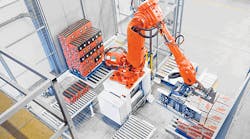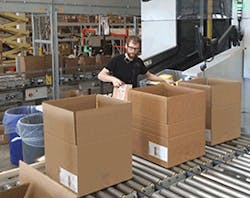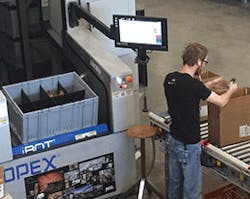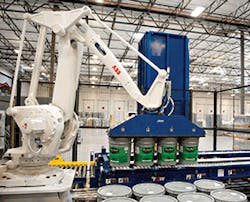Petzl America supplies products that make its customers' trek a little less grueling. Last year, the subsidiary of France-based Petzl, a manufacturer of tools for occupational and adventure climbing, installed technology that's created a less cumbersome path for workers at its U.S. distribution center.
When Petzl opened its new headquarters in West Valley City, Utah, in April 2014, the company added robotics to its picking operations. The company wanted to increase its order fulfillment rates by reducing travel time to products. Prior to the move, operators averaged 75 picks per hour, says Jeff Wood, Petzl America's supply chain director. Now, workers average 300 picks per hour.
"The biggest gain is minimizing the amount of distance operators have to walk," Wood says.
Petzl joined a growing trend in material handling operations. Robots for palletizing, packaging and specialty materials handling will grow at a 10.1% CAGR to $31.3 billion by 2020, according to a recent study conducted by WinterGreen Research.
Safety and efficiency are two of the main reasons the use of robotics is increasing in material handling operations. "It's appropriate to use robotics in offloading from a conveyor belt to a pallet or into a box because the technology to do that is not terribly sophisticated, and robotics can do it much quicker than a person," says Nick Hunt, manager of automotive technology and support group with ABB.
The health sciences and electronics sectors are two industries where robotics manufacturers and integrators are seeing significant growth. In the health sciences field, more companies are adopting robotics to reduce potential contamination, says Walter Langosch, business development, with ESS Technologies Inc.
The use of material handling robots is becoming more popular in these sectors as manufacturers decrease the size, improve the safety and increase the speed of robots, says Langosch, whose company is an integrator for Fanuc.
Easy Picking
The speed of Petzl's robotics and automation system had a significant impact on productivity and will allow the company to increase capacity in the future without major capital investments, Wood says. The company implemented a picking system from OPEX Corp. with the help of material handling systems integrator Bastian Solutions.
At its previous distribution center in nearby Clearfield, Utah, Petzl relied on handheld RF devices to handle picking operations, Wood says. The new picking system minimized travel time for operators. In the new "goods-to-person" system, empty, bar-code labeled cartons move down a conveyor and are diverted by Bastian's automated order routing system to a picking area. At the picking station, the operator receives product from an automated storage and retrieval system. The OPEX robots deliver SKUs in totes from a rack location. The operator picks the appropriate SKUs and the cartons move back to the main line where they proceed to quality control or a pre-ticketing area.
Traditional shuttle-picking technologies require multiple touch points that involve lifts, conveyors and transfers for each pick cycle. The robotic system that Petzl uses features wireless vehicles that store and retrieve totes while moving along a track within the system's racking structure. The shuttles can move horizontally or vertically throughout the structure, or aisle, to reach specific SKU locations and pick stations, according to OPEX. The shuttle also has ergonomic features. When it arrives at a pick station, it can tilt to reduce a worker's need to stretch or lift.
When the operator indicates the pick is complete, the software releases the current shuttle and tote to its location in the racking structure. The next shuttle or tote is immediately placed into position for the next picking sequence.
Capacity to Grow
Petzl has 12 robots in the pick aisle and has the capacity to add eight more robotic shuttles. The company's West Valley City warehouse is only about 10,000 square feet larger than its former location. Even so, the facility has the capacity to handle at least 10 more years of growth, Wood says. That's because the company is only picking out of one end of the automated picking aisle. The system is set up so operators can pick out of both ends of it, if necessary.
"We're using about 20% of the capacity that we could put into this building," Wood says. "That's without any layout changes. We would have to add a conveyor to accommodate a new aisle, but we already have the space built in."
In addition to a fourfold increase of picks per hour, the company has improved picking accuracy. The system does not rely on operators to scan products with handheld devices. Instead, the automated system shows the product, product quantity and location on a screen or an LED display.
The efficiency of the system also enabled the company to increase volume without adding staff, Wood says. The company did not layoff any employees, though, and staff was receptive to the addition of the automation system, Wood says.
Safer Technology
Traditional articulated robotics and robots with vision systems are playing an increasing role in material handling, as well. The health sciences field, a specialty for ESS Technologies, is using more robotics for end-of-line packaging, which includes cartoning, palletizing and case packing, Langosch says.
The robots make material handling processes more efficient, but they can also make them safer, says ABB's Hunt. Environments with heavy materials could result in high injury rates and related insurance costs. The use of robotics to offload products from a conveyor belt to a box can eliminate some of these issues, Hunt says.
In past years, the robots themselves caused safety concerns. Workers entering an area where a robot was in motion could put themselves at risk of an injury. But new technologies have made robots much safer, Langosch says.
Many modern robotic systems now come with electronic area sensors that sense motion, Langosch says. If a robot is on a table performing a function and you need to get parts to that robot, the sensors will detect when a person enters the area, and the robot either goes into a slow-motion mode or stops moving altogether, depending on how close the operator is to the machine.
The process also is more efficient than past robotics safety procedures.
"You don't have to open a guard door, you don't have to press a stop, so there's not a reset time," Langosch says. "In this collaborative effort between the operator and the robot through area sensors, you can reduce the amount of downtime."
Jonathan Katz is a freelance writer based in Cleveland, Ohio.






